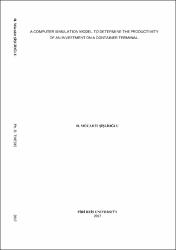| dc.contributor.advisor | Özkaynak, Süleyman | |
| dc.contributor.author | Şişlioğlu, Haydar Mücahit | |
| dc.date.accessioned | 2021-06-05T19:48:44Z | |
| dc.date.available | 2021-06-05T19:48:44Z | |
| dc.date.issued | 2017 | |
| dc.identifier.citation | Şişlioğlu, Haydar Mücahit. (2017). A computer simulation model to determine the productivity of an investment on a container terminal. (Yayınlanmamış Doktora Tezi). Piri Reis Üniversitesi, Fen Bilimleri Enstitüsü, Deniz Ulaştırma İşletme Mühendisliği Ana Bilim Dalı | en_US |
| dc.identifier.uri | https://tez.yok.gov.tr/UlusalTezMerkezi/TezGoster?key=7lOJX8w_8PRQU1mSHU6-jtQT--EUWdZuwla9Fsc6PiVBBQmqLhq1Zj-HEog-MFP7 | |
| dc.identifier.uri | https://hdl.handle.net/20.500.12960/60 | |
| dc.description | YÖK Tez No: 476653 | en_US |
| dc.description | Doktora | en_US |
| dc.description.abstract | Limanlar, ulaştırma ve global ticari faaliyetlerde önemli rol oynamaktadırlar. Milyonlarca ton ticari mal küresel ekonominin işleyişi içinde limanlarda işlem görmektedirler. Limanların verimli ve etkin çalışmasının sağlanması ile altyapı yeteneklerinin geliştirilmesinde optimum yatırım seçeneklerinin seçimi maksadıyla, matematiksel yöntemlerin kullanımı gerekli olmaktadır. Bu tezde; konteyner terminali altyapısının geliştirilmesi için en etkin yatırım alternatifi seçiminde, benzetim modellerinin ve Veri Zarflama Analizi optimizasyon yönteminin avantajlarını birleştiren bir yaklaşım kullanılmıştır. Bu amaçla, bir intermodal konteyner terminalinde yürütülen faaliyetlerin bezetimini yapan ayrık benzetim modeli kullanılarak, limanda aylık olarak elleçlenen toplam konteyner sayısının ve ortalama gemi servis süresinin farklı yatırım senaryoları için tahmin edilmesi yaklaşımı esas alınmıştır. Hedef olarak seçilen konteyner terminali için optimum yatırım kararının belirlenmesinde, 16 değişik benzetim senaryosu ve her bir senaryo için de terminal ekipmanlarının farklı bileşenleri modelde girdi olarak kullanılmıştır. Söz konusu ekipman parametreleri; rıhtım uzunluğu, rıhtımdaki vinç sayısı, konteyner taşıyan çekici/kamyon sayısı ve konteyner depolama alanında kullanılan vinç sayısıdır. Optimizasyonun amacı; gemilerin limanda kaldığı ortalama toplam süreyi en aza indirmek ve aynı zamanda elleçlenen konteyner miktarını azami sayıya çıkartmaktır. Takip eden aşamada, konteyner benzetim senaryoları çıktılarının birbirlerine göre etkinliklerinin değerlendirilmesi için Veri Zarflama Analizi yöntemi kullanılmıştır. Tezin son bölümünde, Veri Zarflama Analizi sonuçlarını ve altyapı yatırım maliyetlerini girdi olarak kabul eden maliyet etkinlik analizi neticesinde, temel konteyner terminalinin geliştirilmesi için gerekli olan minimum maliyetli optimum yatırım paketi karar teklifi oluşturulmuştur . | en_US |
| dc.description.abstract | Because of the dynamic nature of the maritime transportation environment, a large number of timely decisions have to be continuously reviewed in accordance with the changing conditions of the container terminal system. The development of a terminal to its optimum capacity with minimum infrastructure investment basically depends on the efficient loading and unloading of ships, trains and trucks using the terminal equipment's and the rapid movement of containers in and out of the terminal area. In this thesis, it has been presented an approach that combines the advantages of simulation models and Data Envelopment Analysis optimization method in order to reach an optimum investment decision for the enhancement of a container terminal. For this purpose it was decided to approach the problem by a discrete event simulation model, in order to reproduce the activities carried out inside a container terminal, to estimate the monthly container throughput and average ship turnaround time for different investment scenarios. To be able to evaluate the optimum investment decision for the target container terminal, total of 16 simulation scenario were employed. For each scenario, different sets of terminal equipment were assigned to simulation model as input. These parameters are length of quay, number of quay cranes, yard trucks and yard cranes. The objective is, on the one side, to minimize average ship turnaround time and on the other side, to maximize container throughput generated by the terminal. As a follow on step, Data Envelopment Analyses method is utilized as a tool to evaluate the relative efficiencies of these outputs gathered from container simulation scenarios. At the end, cost efficiency analysis is conducted to be able to decide best investment package for the enlargement of the target container terminal with minimum cost. | en_US |
| dc.language.iso | eng | en_US |
| dc.publisher | Piri Reis Üniversitesi | en_US |
| dc.rights | info:eu-repo/semantics/openAccess | en_US |
| dc.subject | Denizcilik | en_US |
| dc.subject | Marine | en_US |
| dc.subject | Endüstri ve Endüstri Mühendisliği | en_US |
| dc.subject | Industrial and Industrial Engineering | en_US |
| dc.subject | Ulaşım | en_US |
| dc.subject | Transportation | en_US |
| dc.subject | Benzetim | en_US |
| dc.subject | Simulation | en_US |
| dc.subject | Konteyner taşımacılığı | en_US |
| dc.subject | Container transportation | en_US |
| dc.title | A computer simulation model to determine the productivity of an investment on a container terminal | en_US |
| dc.title.alternative | Konteyner terminline yapılacak optimum yatırımın seçiminde bilgisayar similasyon modellemesinin kullanımı | en_US |
| dc.type | doctoralThesis | en_US |
| dc.department | Lisansüstü Eğitim Enstitüsü, Deniz Ulaştırma İşletme Mühendisliği Ana Bilim Dalı | en_US |
| dc.contributor.institutionauthor | Şişlioğlu, Haydar Mücahit | |
| dc.identifier.startpage | 1 | en_US |
| dc.identifier.endpage | 205 | en_US |
| dc.relation.publicationcategory | Tez | en_US |

















